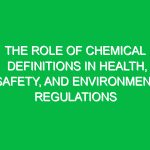Introduction
In the construction industry, where the stakes are high and the environment is often unpredictable, workplace safety cannot be treated as an afterthought. The Health, Safety, and Environment (HSE) domain is critical in managing risks and ensuring that workers return home safely at the end of each day. An integral part of this domain is the concept of “examples of” safety practices—real-world applications that demonstrate effective strategies for mitigating hazards. By examining innovative methods and practical examples of safety enhancements, we can not only improve safety standards but also foster a culture of care and responsibility among workers.
The relevance of “examples of” in HSE extends beyond theoretical knowledge. They serve as benchmarks for best practices, inspiring organizations to implement effective safety measures tailored to their specific contexts. These examples can range from the use of advanced technology to innovative training programs, each contributing to a safer work environment.
Identifying Hazards in Construction
The construction industry is fraught with hazards, each posing unique risks to workers. Potential hazards can be categorized into several areas:
Physical Hazards
Physical hazards include slips, trips, falls, and being struck by objects. For instance, a construction worker on a high-rise building may face the risk of falling from scaffolding due to inadequate safety harnesses or improper assembly. According to the Occupational Safety and Health Administration (OSHA), falls are the leading cause of death in the construction industry.
Chemical Hazards
Chemicals used in construction, such as solvents, paints, and adhesives, can pose serious health risks. Workers may be exposed to harmful fumes that can lead to respiratory issues. For example, during the renovation of an old building, lead paint might be disturbed, exposing workers to lead poisoning if proper precautions are not taken.
Mechanical Hazards
The operation of heavy machinery, such as cranes and excavators, introduces mechanical hazards. Workers may suffer severe injuries if they operate machinery without following safety protocols or if the machinery malfunctions. A notable case involved a construction site where a crane operator was injured due to a failure to conduct routine equipment checks.
Ergonomic Hazards
Many construction tasks require repetitive motions or heavy lifting, leading to musculoskeletal disorders. For instance, workers who frequently lift heavy materials without proper techniques may develop chronic back pain. Implementing ergonomic practices can significantly reduce these risks.
Best Practices and Safety Precautions
To combat these hazards, construction companies can adopt several best practices. Here are actionable strategies that have proven effective:
Utilizing Technology
One of the most innovative ways to enhance safety is through the integration of technology. For example, wearable devices equipped with sensors can monitor workers’ movements and detect hazardous conditions, such as excessive fatigue or proximity to dangerous machinery. Companies like SmartCap Technologies have developed caps that can identify when a worker is fatigued, alerting them before an incident occurs.
Implementing Comprehensive Training Programs
Training is paramount in ensuring that all workers are aware of the risks associated with their tasks. A construction firm in California implemented a rigorous training program that included virtual reality (VR) simulations of hazardous scenarios. This immersive experience allowed workers to practice safety protocols in a controlled environment, resulting in a significant reduction in accidents on-site.
Regular Safety Audits and Inspections
Conducting regular safety audits helps identify potential hazards before they lead to incidents. A construction company in Texas adopted a proactive approach by employing third-party safety consultants to conduct inspections. This initiative not only improved compliance with safety regulations but also fostered a culture of accountability among workers.
Developing a Safety Culture
Creating a culture of safety involves engaging workers at all levels in safety discussions. This can be achieved through safety committees where employees can voice concerns and suggest improvements. For instance, a construction company in New York implemented a “safety suggestion box,” allowing workers to anonymously submit ideas for enhancing safety protocols. This initiative led to the adoption of several valuable safety measures based on frontline worker feedback.
Proper Use of Personal Protective Equipment (PPE)
Ensuring that all workers wear appropriate PPE is critical. This includes hard hats, safety goggles, gloves, and high-visibility clothing. A construction site in Florida reported a significant decrease in injuries after introducing an incentive program that rewarded workers for consistent PPE use, demonstrating the effectiveness of positive reinforcement.
Regulations and Standards Governing Workplace Safety
Understanding the regulatory landscape is essential for compliance and safety. Key regulations include:
Occupational Safety and Health Act (OSHA)
OSHA sets forth standards that govern workplace safety in the construction industry. Employers are required to provide a safe working environment, which includes ensuring that all safety protocols are followed.
Citation Guidelines
OSHA issues citations for non-compliance with safety standards. The severity of these citations can impact a company’s reputation and financial standing. Therefore, adhering to standards is not just a legal requirement but also a strategic business practice.
Environmental Protection Agency (EPA) Regulations
The EPA regulates hazardous materials used in construction. Compliance with these regulations is essential not only for worker safety but also for environmental protection. Companies must ensure that they dispose of hazardous materials correctly to avoid legal repercussions.
Conclusion
Enhancing workplace safety in the construction industry requires a multifaceted approach that incorporates innovative strategies, robust training programs, and a commitment to compliance with regulations. By learning from “examples of” effective practices, organizations can mitigate risks and create safer environments for workers. The integration of technology, the establishment of a safety culture, and the adherence to regulatory standards are all critical components in this ongoing effort.
Ultimately, the goal is to foster a workplace where safety is a shared responsibility, ensuring that every worker feels valued and protected. As the construction industry evolves, so too must our approaches to safety, continually adapting to new challenges and innovations. By prioritizing safety, we not only protect our workforce but also contribute to the sustainability and success of the construction sector as a whole.


